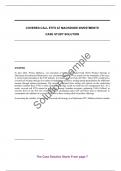Case
Case Solution for Covered Call ETFs at Mackenzie Investments
- Course
- Institution
Get the Covered Call ETFs at Mackenzie Investments Case Study Solution and Analysis by Walid Busaba, Brett Gugel | Case ID: W34859. We guarantee that this case solution is 100% original, official, and not AI-generated. It is a plagiarism-free, complete, and well-structured solution, perfect for exa...
[Show more]



